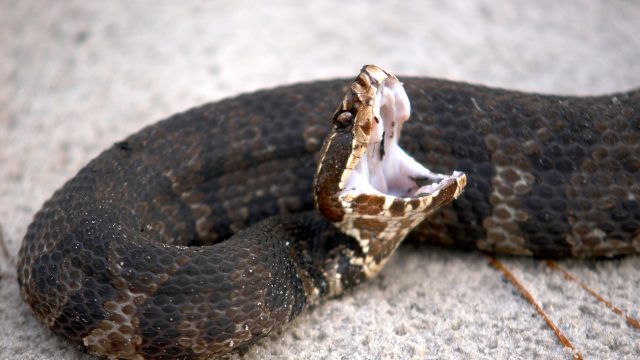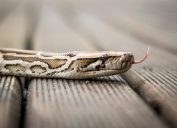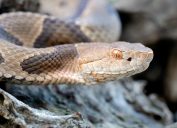It's Snake Bite Season: "Stay Away" From These Areas, Officials Warn
You may want to steer clear of these places during this time of year to avoid a close encounter.
No matter the time of year, it's always a good idea to keep a keen eye on your surroundings for any possible snake run-ins around your yard or out in nature. After all, they're an essential part of the ecosystem whose habitat we happen to share. But it's during the warmer months when both snakes and humans become more active—especially in places where they may be bound to cross paths. And now that it's officially snake bite season, officials are warning it's best to "stay away" from specific areas. Read on to find out where you should exercise extra caution.
READ THIS NEXT: The No. 1 Sign There's a Snake in Your Bathroom.
Snake bite season runs longer than many people realize.

For humans, the return of warm weather each year means outdoor activities are back on the table. But experts caution that the same time you're picking back with gardening or hiking is also when snakes are becoming more active after a long winter, too.
"Snakes are cold-blooded, meaning that they rely on external sources, such as the sun, for a large chunk of their warmth and energy," Stewart Flynn of Bug-N-A-Rug Exterminators previously told Best Life. "That means that they can often be found laying in the sun to soak up the heat, especially during the summer."
Depending on weather patterns and where you live, the high season for snake bites typically begins in April and stretches through October, according to the U.S. Department of Agriculture's (USDA) Forest Service. Each year, there are 8,000 reported bites from venomous snakes, with 10 to 15 resulting in death, per Food & Drug Administration (FDA) data. And if you live in an area where dangerous reptiles are a known presence, experts say to keep clear of one place in warmer months.
Officials say there's one place you should "stay away" from during snake bite season.
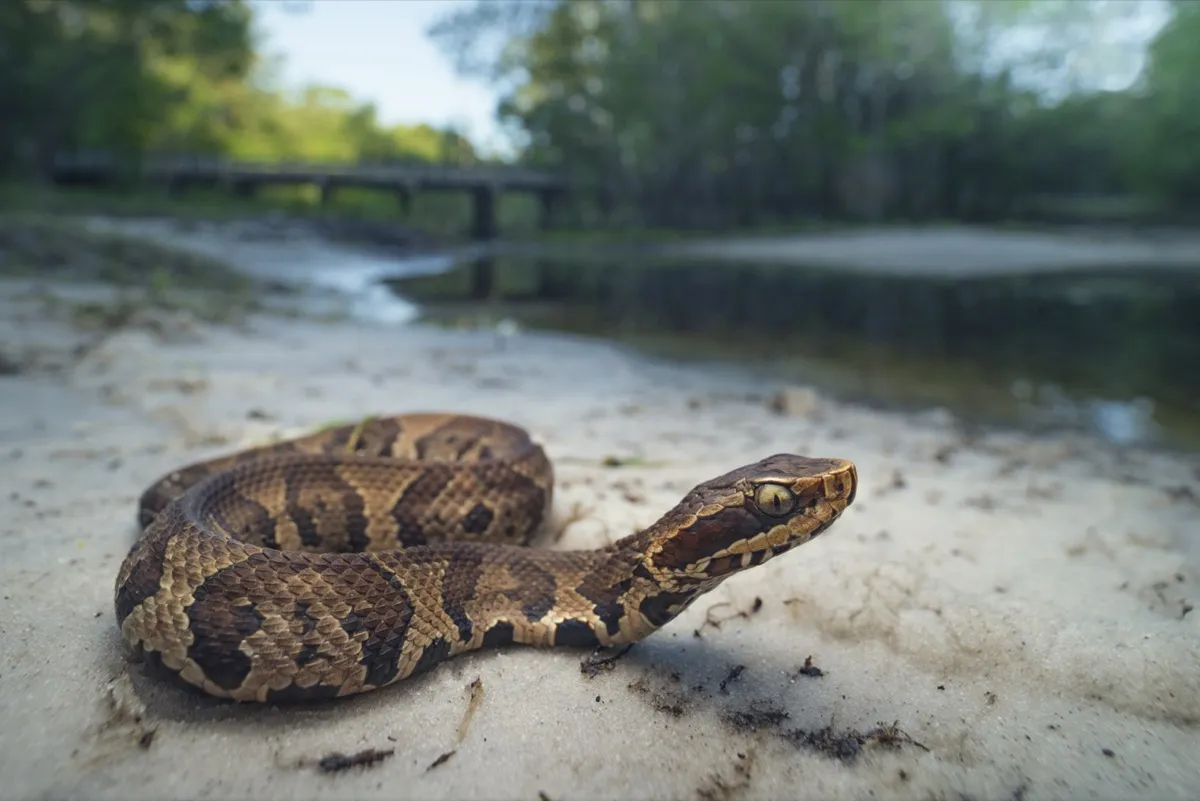
On Aug. 30, police in Pembroke Pines, Florida were called to a residence after a venomous cottonmouth snake was spotted slithering in the vicinity, local Fox affiliate WSVN reports. While they were able to catch it quickly, the officers unfortunately euthanized the snake because they were unable to relocate it.
However, local officials warned that the run-in with the water moccasin is a reminder that it's essential to remain vigilant during the warmer months. They emphasized that extra caution should be taken when walking near tall grass and that it's best to avoid shaded areas during snake bite season in order to steer clear of the reptiles.
RELATED: For more up-to-date information, sign up for our daily newsletter.
Experts say snakes can be very sensitive to extreme temperatures.

Because they rely on the sun and the elements to help regulate their body temperatures, snakes are often found sunning themselves as the temperatures creep upwards. But experts say that, similar to humans, too much direct sunlight can be just as problematic as being too cold.
"Most snakes—especially the venomous ones—overheat easily in the sun, and so they don't spend much time out in the open," Emily Taylor, PhD, a professor of biological science at California Polytechnic State University, San Luis Obispo and owner of Central Coast Snake Services, wrote in a Medium post. "They seek shade under bushes, in rodent burrows…or under your porch or toolshed."
Taylor says this basic living necessity helps create the conditions for snakes to feel welcome in some yards. "Firewood, rock piles, and stacked tiles, tin siding, or plywood literally create snake mansions. Many properties also have sheds that are raised slightly above-ground, creating a few inches of perfectly snakey crawl space underneath," she points out.
There are ways you can make your property less hospitable to snakes.
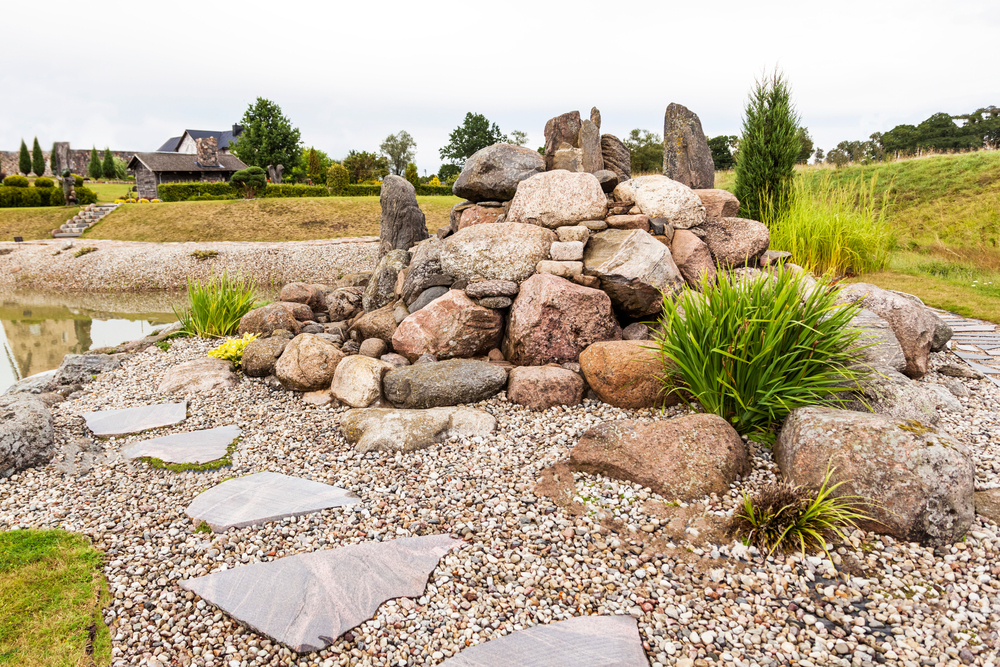
Of course, you won't be spending your entire summer under the full blast of the sun's rays just to avoid snakes. Taylor says that instead of ditching objects like patio umbrellas, it's best to focus on removing structures and lawn elements that make the reptiles feel at home.
"The key to making your yard unattractive to snakes is to eliminate what I call 'low shade.' This includes shade-providing structures, objects, and plants that are low to the ground and provide both shade and hiding spots for snakes," she writes, specifically citing "bushy plants like rosemary, lavender, or Lantana shrubs" as a notorious hiding spot for snakes in many yards.
"A yard that is unattractive to snakes—especially the venomous ones—has the following characteristics: the grass is kept mowed; plants chosen for landscaping are 'spindly' rather than bushy so that they cast little shade and you can easily see the base of the bush; firewood is stored on a table or other platform elevated a few feet above the ground, with no debris piles; and snakes cannot crawl underneath the buildings because they are flush with the ground or because access under porches or into crawl spaces is blocked off," Taylor suggests.
And it's not just about how your yard looks. It's also best to pay attention to your surroundings first thing in the morning and at night when snakes are most active during the hours of decreased sunlight and heat, Lt. Scott Mullin, a member of Miami-Dade Fire Rescue's Venom Response Team, told the South Florida Sun-Sentinel in a 2018 interview.
